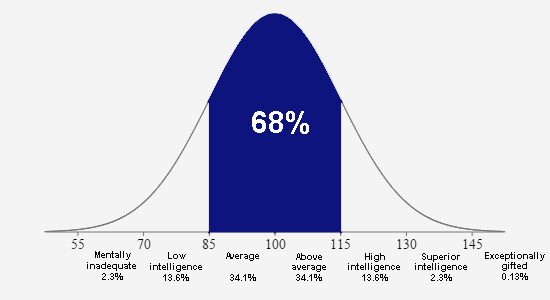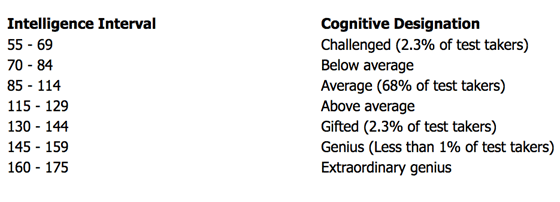Norm
DynamIQ Tests (Unique) Norm
Roberto Enea
1. Introduction
DynamIQ is the first dynamic spatial IQ test ever: it includes a very large set of different, online and multiple-choice, spatial items (about 24008≈1.1x1027), that are arranged in groups of 40 items for a single test, and all the possible tests have a unique norm!
In fact, the test is dynamically generated and is a different test every time but with the same difficulty level for each group of items. This aspect guarantees on one hand the respect of the norm of the test and on the other hand that the test is not exceeded by deception.
Moreover, DynamIQ is unquestionably independent from the culture of test takers (100% culture-fair). It is a spatial test, with each item that is composed by a matrix of 9 images generated through the composition of three basic shapes: Square, Circle and Equilateral Triangle. The result is a big amount of images (more than 2400), that can be combined to generate the 3x3 matrices. The proposed answers are 8 choices, that include the correct solution of the item (and the solution can be easily proved to be unique for every possible item) [1].
Unlike classic IQ tests, High-Range IQ Tests are designed with the goal of seeking out the geniuses and top class geniuses: this test contains 40 items, has a time limit of 25 minutes and can measure up to 172 (S.D.=15) IQ scores, equivalent to 0.000079% of the unselected adult population (less than 1 out of 1 million people) [2].


2. Norming method
In his “Norming of high-range I.Q. tests” [3], Paul Cooijmans provides two different approaches (plus a third one that is very complex and rarely used) and we chose the first basic norming method, using z-scores to equate distributions of raw and prior scores. Thus, we proceded as follows:
1 – Norming based on the candidates’ known scores on other tests (called “equation” or “anchoring”): we selected 40+ well known people from the High IQ World (i.e., people who belong to recognized high IQ societies and/or people who took at least two supervised IQ tests), plus 20+ common people in the age range of 18 to 59 years, who had already attempted at least one recognized IQ test. In addition, we included also a few people who showed interest in IQ tests and attempted only online (unofficial) IQ tests, plus a single candidate without previous scores (we assigned him a standard score of 100).
1.1 – For norming purposes, we taken into account only submissions by those candidates who sent the test in time and who answered to at least 4 questions. So, we got only 40 valid submissions with a minimum raw score achieved of 11. Moreover, in our norm, we will provide IQs only for raw scores above 10.00, since 10.00 is the raw score that every testee can achieve avoiding to answer to any items, sending the test as it is at the beginning of the challenge.
2 – We selected a strict list of recognized IQ tests (i.e., test accepted to join well known high IQ societies such as Mensa, IIS, ePiq society, Glia, sPIqr, WIQF, Prometheus Society, Mega Society, and so on), both supervised and unsupervised, and we calculated a z-score for each testee who took at least one of the aforementioned IQ tests. The z-score is basically the arithmetic mean of all the previous scores for each testee, expressing those values in a standard deviation of 15 and rounding each score to the lowest integer value (in order to mitigate the well known problem related to people who avoids to report all their previous scores, even if we insisted very much on this point, selecting almost just trusted “IQ friends”).
3 – We equated the average scores for the 5 candidates who took online tests only and the scores on the same (online) 3x3 Matrices tests (e.g., iqtest.dk) by people who already received a z-score as explained above. This group finally received a “standard” z-score of 120, which is very close to their average performance on iqtest.dk (120.8 SD=15).
4 – As Paul Cooijmans explains, “Equating z-scores always and necessarily results in a linear norm table and therefore is only recommended (…) when the object test has been constructed carefully to contain equal numbers of items of each level of difficulty”. So, “As in rank equation, two (conceptual, hypothetical) columns are formed with the paired raw and other scores. Weighting of score pairs is possible in the same way as described for rank equation. For each column, mean and standard deviation (S.D.) are computed. To obtain norms, mean raw score is set equal to mean I.Q. (or whichever scale one uses for the other tests). And for each raw score point above or below that, I.Q.S.D./R.S.D. (I.Q. S.D. divided by Raw S.D.) is added or subtracted to or from the mean I.Q.”.
Thus, we obtained the data as follows:
Mean I.Q. = 135.4
I.Q.S.D. = 16.4688
R.S.D. = 4.6746
I.Q.S.D./R.S.D. = 3.523
Hence, the norm can be expressed by the formula below:
I.Q. = RawScore * 3.523 + 31.118
3. Further data about our testees
Candidates who sent the test in time and answered to 4+ items: 40
Recognized IQ tests previously taken: 118
Raw scores range: [11.00-36.00]
z-scores range: [100-162]
Candidates’ Scores Distribution:
RAW SCORE (x) IQ RANGE S.D. 15 AVG z-score Score Histogram (40), Outliers (0)
0 ≤ x < 12 [0, 73.4) 100 *
12 ≤ x < 14 [73.4, 80.4) N/A
14 ≤ x < 16 [80.4, 87.5) N/A
16 ≤ x < 18 [87.5, 94.5) N/A
18 ≤ x < 20 [94.5, 101.6) 100 *
20 ≤ x < 22 [101.6, 108.6) N/A
22 ≤ x < 24 [108.6, 115.7) 112 *
24 ≤ x < 26 [115.7, 122.7) 125 *
26 ≤ x < 28 [122.7, 129.8) 126 *******
28 ≤ x < 30 [129.8, 136.8) 130 *****
30 ≤ x < 32 [136.8, 143.9) 137 ********
32 ≤ x < 34 [143.9, 150.9) 144 ***********
34 ≤ x < 36 [150.9, 157.9) 151 ****
36 ≤ x < 38 [157.9, 165.0) 162 *
38 ≤ x ≤ 40 [165.0, 172.0(+)] N/A
About the ceiling effect of the test, Paul Cooijmans (in his article about how to norm an High Range I.Q. Test [3]) says: “As a rule of thumb, extrapolating outside the raw score distribution becomes uncertain when done over a distance greater than half the square root of the actual range of the scores. Also, norms tend to become uncertain at the edges of the test, which (the edges) as a rule of thumb may be defined as the top and bottom half square root of the total possible score range (the total possible score range is the difference between the maximum and minimum possible scores, regardless of the fact whether or not those have been reached)”.
Since we wish the to be as strict as we can, we prefer to give the certain score range of DynamIQ as follows:
Let’s define 0.5 * sqrt(Maximum RawScore achieved - Minumum RawScore achieved) as R, we have that the certain score range is [11-R, 36+R].
Thus, R = 0.5 * sqrt(36 – 11) = 2.5, so the actual RawScore range of DynamIQ is [10.25, 38.50] corresponging to a certain IQ score range of [67.23, 166.75] (SD=15), while the maximum IQ performance theorically achievable (without taking into account ceiling effects) remains 172.04 (99.9999205647th percentile - rarity 1 out of 1,258,887 unselected adults) [2].
Basing on the second method provided by Paul Cooijmans we have that the edges, as in the article [3], are the top and bottom half square root of the possible score range, so start at 0 + 0.5*sqrt(40) = 3.16 and 40 - 0.5*sqrt(40) = 36.84, which (in our test) implies a maxumum highly accurate raw score of 36.75, corresponding to IQ 160.59 S.D.=15 (99.997th percentile – rarity 1 out of 35,000 unselected adults).
So, at the high end, DynamIQ can provide a very accurate IQ assessment (S.D.=15) in the range [67, 161], a good IQ evaluation from 162 to 167 and a conceivable IQ estimation, considering a moderate risk of ceiling effects, up to 172.
Hence, the Raw Score->IQ conversion table is as follows:
|
RAW SCORE |
IQ (SD=15) |
|
[0,00 – 10,00] |
#NULL |
|
10,25 |
67,23 |
|
10,50 |
68,11 |
|
10,75 |
68,99 |
|
11,00 |
69,87 |
|
11,25 |
70,75 |
|
11,50 |
71,63 |
|
11,75 |
72,51 |
|
12,00 |
73,39 |
|
12,25 |
74,28 |
|
12,50 |
75,16 |
|
12,75 |
76,04 |
|
13,00 |
76,92 |
|
13,25 |
77,80 |
|
13,50 |
78,68 |
|
13,75 |
79,56 |
|
14,00 |
80,44 |
|
14,25 |
81,32 |
|
14,50 |
82,20 |
|
14,75 |
83,08 |
|
15,00 |
83,96 |
|
15,25 |
84,84 |
|
15,50 |
85,73 |
|
15,75 |
86,61 |
|
16,00 |
87,49 |
|
16,25 |
88,37 |
|
16,50 |
89,25 |
|
16,75 |
90,13 |
|
17,00 |
91,01 |
|
17,25 |
91,89 |
|
17,50 |
92,77 |
|
17,75 |
93,65 |
|
18,00 |
94,53 |
|
18,25 |
95,41 |
|
18,50 |
96,29 |
|
18,75 |
97,18 |
|
19,00 |
98,06 |
|
19,25 |
98,94 |
|
19,50 |
99,82 |
|
19,75 |
100,70 |
|
20,00 |
101,58 |
|
20,25 |
102,46 |
|
20,50 |
103,34 |
|
20,75 |
104,22 |
|
21,00 |
105,10 |
|
21,25 |
105,98 |
|
21,50 |
106,86 |
|
21,75 |
107,74 |
|
22,00 |
108,62 |
|
22,25 |
109,51 |
|
22,50 |
110,39 |
|
22,75 |
111,27 |
|
23,00 |
112,15 |
|
23,25 |
113,03 |
|
23,50 |
113,91 |
|
23,75 |
114,79 |
|
24,00 |
115,67 |
|
24,25 |
116,55 |
|
24,50 |
117,43 |
|
24,75 |
118,31 |
|
25,00 |
119,19 |
|
25,25 |
120,07 |
|
25,50 |
120,96 |
|
25,75 |
121,84 |
|
26,00 |
122,72 |
|
26,25 |
123,60 |
|
26,50 |
124,48 |
|
26,75 |
125,36 |
|
27,00 |
126,24 |
|
27,25 |
127,12 |
|
27,50 |
128,00 |
|
27,75 |
128,88 |
|
28,00 |
129,76 |
|
28,25 |
130,64 |
|
28,50 |
131,52 |
|
28,75 |
132,41 |
|
29,00 |
133,29 |
|
29,25 |
134,17 |
|
29,50 |
135,05 |
|
29,75 |
135,93 |
|
30,00 |
136,81 |
|
30,25 |
137,69 |
|
30,50 |
138,57 |
|
30,75 |
139,45 |
|
31,00 |
140,33 |
|
31,25 |
141,21 |
|
31,50 |
142,09 |
|
31,75 |
142,97 |
|
32,00 |
143,86 |
|
32,25 |
144,74 |
|
32,50 |
145,62 |
|
32,75 |
146,50 |
|
33,00 |
147,38 |
|
33,25 |
148,26 |
|
33,50 |
149,14 |
|
33,75 |
150,02 |
|
34,00 |
150,90 |
|
34,25 |
151,78 |
|
34,50 |
152,66 |
|
34,75 |
153,54 |
|
35,00 |
154,42 |
|
35,25 |
155,31 |
|
35,50 |
156,19 |
|
35,75 |
157,07 |
|
36,00 |
157,95 |
|
36,25 |
158,83 |
|
36,50 |
159,71 |
|
36,75 |
160,59 |
|
37,00 |
161,47 |
|
37,25 |
162,35 |
|
37,50 |
163,23 |
|
37,75 |
164,11 |
|
38,00 |
164,99 |
|
38,25 |
165,87 |
|
38,50 |
166,75 |
|
39,00 |
168,52 |
|
39,25 |
169,40 |
|
40,00 |
172,04(+) |
Nota Bene:
No time bonus points awarded for tests completed correctly before the time limit of 25 minutes.
Referring to ENSDT 20, a High Range IQ Test very similar to DynamIQ and accepted by many recognized High IQ Societies, r has been also calculated:
r(ENSDT 20, DynamIQ) = 0.722 (n=11) ; p < .01
The r between DynamIQ and every spatial HRTs taken by our candidates is as follows:
r(SPATIAL HRTs, DynamIQ) = 0.869 (n = 54 ; p < 0.05)
While, the r between DynamIQ and candidates’ supervised tests is as follows:
r(SUPERVISED TESTS, DynamIQ) = 0.762 (n = 9)
Considering a couple of other recognized HTRs (n is very small due to the big amount of HRTs available), respectively by Paul Laurent and Jason Betts, we have that:
r(MCST 40, DynamIQ) = 0.646 (n = 4)
r(WIT, DynamIQ) = 0.582 (n = 4)
Referring to candidates’ average z-score and their performance on DynamIQ, r has been also calculated:
r(AVG z-scores; DynamIQ) = 0.739 (n = 39)
Thus, there is a strong positive correlation between ENSDT 20 and DynamIQ, but the linear dependence between the previous IQ performances of our testees and their scores on DynamIQ are even higher, and it is an obvious consequence of the aforementioned linear norm table.
4. Conclusion
In conclusion, DynamIQ is a high qualitative IQ test and the first dynamic spatial IQ test ever; it is culture free and totally immune from the risk of cheating. The norm of the test is unique and can provide a highly accurate IQ assessment in the range [67, 161] (S.D.=15), with a maximum score achievable of 172 (almost a record for a reliable/strictly normed online IQ test).
As explained in the first section of this paper, the norm will not change from test to test and the candidate cannot increase his scores attempting DynamIQ over and over, thanks to the dynamic configuration of every item that cannot let the testee learn from his previous mistakes.
For these reasons, we hope that most recognized High IQ Societies, Companies and Institutions will decide to adopt the best and the most secure spatial IQ test currently available on the market, a deep look into the future of the IQ testing assessment in the Web 2.0 era.
References
[1] P. Cooijmans, Recommendations for conducting high-range intelligence tests, Web. March 2007, Rev. May 2010, http://www.paulcooijmans.com/intelligence/recommend.html
[2] R. de la Jara, IQ percentile and rarity chart, http://www.iqcomparisonsite.com/IQtable.aspx
[3] P. Cooijmans, Norming of high-ranges I.Q. Tests, Web. 2002, Rev. 2013, http://www.paulcooijmans.com/intelligence/normhighrange.html
